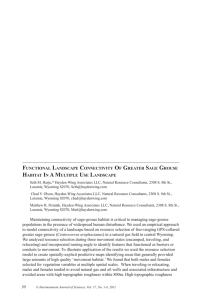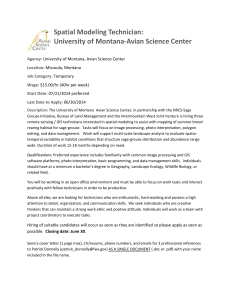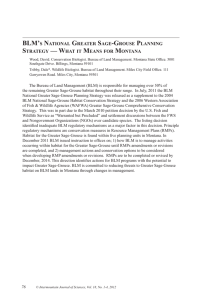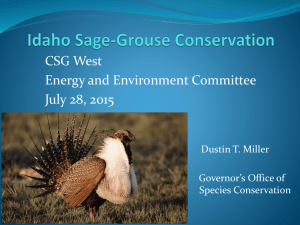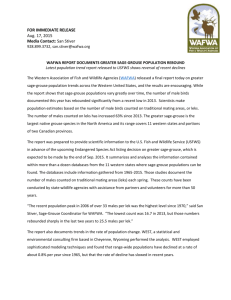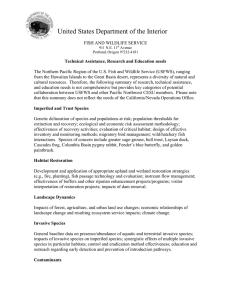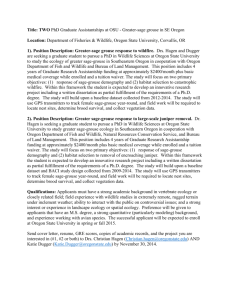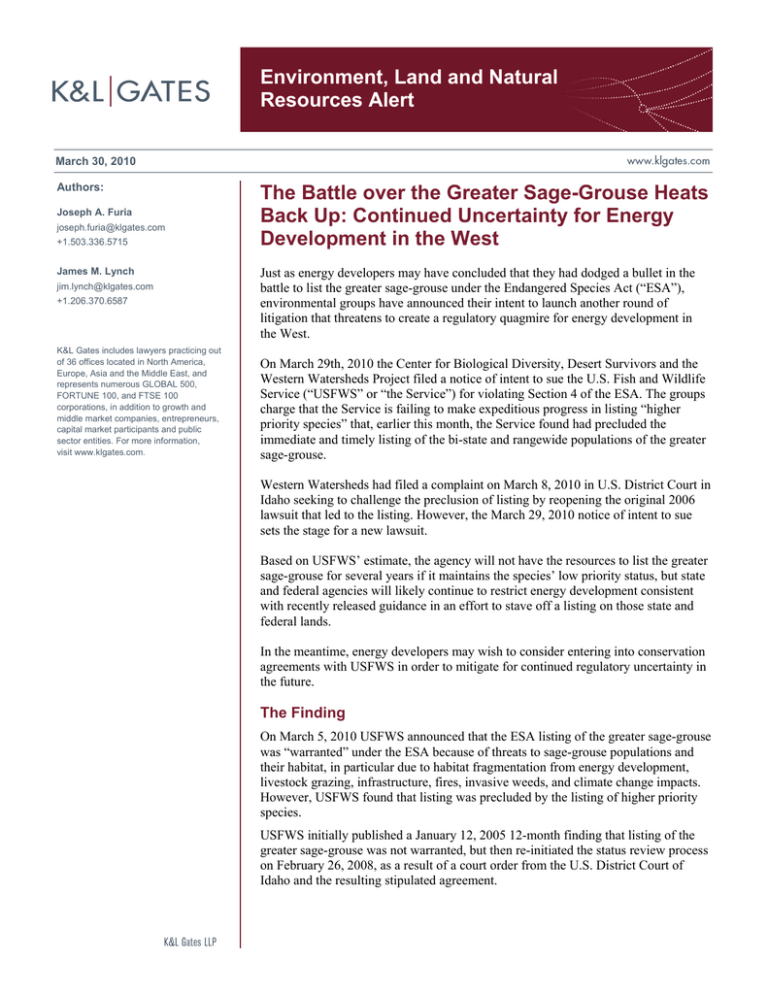
Environment, Land and Natural
Resources Alert
March 30, 2010
Authors:
Joseph A. Furia
joseph.furia@klgates.com
+1.503.336.5715
James M. Lynch
jim.lynch@klgates.com
+1.206.370.6587
K&L Gates includes lawyers practicing out
of 36 offices located in North America,
Europe, Asia and the Middle East, and
represents numerous GLOBAL 500,
FORTUNE 100, and FTSE 100
corporations, in addition to growth and
middle market companies, entrepreneurs,
capital market participants and public
sector entities. For more information,
visit www.klgates.com.
The Battle over the Greater Sage-Grouse Heats
Back Up: Continued Uncertainty for Energy
Development in the West
Just as energy developers may have concluded that they had dodged a bullet in the
battle to list the greater sage-grouse under the Endangered Species Act (“ESA”),
environmental groups have announced their intent to launch another round of
litigation that threatens to create a regulatory quagmire for energy development in
the West.
On March 29th, 2010 the Center for Biological Diversity, Desert Survivors and the
Western Watersheds Project filed a notice of intent to sue the U.S. Fish and Wildlife
Service (“USFWS” or “the Service”) for violating Section 4 of the ESA. The groups
charge that the Service is failing to make expeditious progress in listing “higher
priority species” that, earlier this month, the Service found had precluded the
immediate and timely listing of the bi-state and rangewide populations of the greater
sage-grouse.
Western Watersheds had filed a complaint on March 8, 2010 in U.S. District Court in
Idaho seeking to challenge the preclusion of listing by reopening the original 2006
lawsuit that led to the listing. However, the March 29, 2010 notice of intent to sue
sets the stage for a new lawsuit.
Based on USFWS’ estimate, the agency will not have the resources to list the greater
sage-grouse for several years if it maintains the species’ low priority status, but state
and federal agencies will likely continue to restrict energy development consistent
with recently released guidance in an effort to stave off a listing on those state and
federal lands.
In the meantime, energy developers may wish to consider entering into conservation
agreements with USFWS in order to mitigate for continued regulatory uncertainty in
the future.
The Finding
On March 5, 2010 USFWS announced that the ESA listing of the greater sage-grouse
was “warranted” under the ESA because of threats to sage-grouse populations and
their habitat, in particular due to habitat fragmentation from energy development,
livestock grazing, infrastructure, fires, invasive weeds, and climate change impacts.
However, USFWS found that listing was precluded by the listing of higher priority
species.
USFWS initially published a January 12, 2005 12-month finding that listing of the
greater sage-grouse was not warranted, but then re-initiated the status review process
on February 26, 2008, as a result of a court order from the U.S. District Court of
Idaho and the resulting stipulated agreement.
Environment, Land and Natural Resources Alert
USFWS combined the status review for the greater
sage-grouse with a review of the listing
determinations for three subpopulations: the Bi-State
population (formerly the Mono Basin population),
the western subspecies of greater sage-grouse, and
the Columbia Basin (Washington) population.
USFWS concluded that the western subspecies of
greater sage-grouse did not meet the criteria of a
distinct population segment (“DPS”) and therefore
the Service would not consider it separately for
listing. However, USFWS concluded that the BiState population of greater sage-grouse, located in
eastern California and western Nevada, was a valid
DPS and warranted listing, but it was precluded by
the need to list other species of greater priority.
USFWS assigned a listing priority number (“LPN”)
of 3 to the Bi-State population, finding that it was at
higher risk of extinction that the greater sage-grouse
(which received a LPN of 8). USFWS also stated
that it would publish an updated finding regarding
the Columbia Basin DPS, which the Service had
found on May 7, 2001 to warrant listing, but was
precluded.
Five Factors
Under Section 4 of the ESA, USFWS may determine
a species to be endangered or threatened on the basis
of five factors:
(A) Present or threatened destruction, modification,
or curtailment of habitat or range;
(B) overutilization for commercial, recreational,
scientific, or educational purposes;
(C) disease or predation;
(D) inadequacy of existing regulatory mechanisms;
or
(E) other natural or manmade factors affecting its
continued existence.
Under Factor A, USFWS considered the impacts of
habitat conversion for agriculture, urbanization,
infrastructure, powerlines, communication towers,
fences, roads, railroads, fire, invasive weeds and
pinyon-juniper encroachment, grazing, energy
development (renewable and nonrenewable), and
climate change. USFWS concluded that these
impacts contributed to habitat fragmentation and
degradation – the primary causes of the decline
greater sage-grouse.
USFWS concluded that Factor B (overutilization for
commercial, recreational, scientific, or educational
purposes) was not a significant threat to the species
such that listing was warranted. The same was true
of Factor C (disease and predation), although the
Service did note some concern with regard to future
expansion of West Nile Virus and increased
predation due to habitat fragmentation.
Under Factor D (inadequacy of existing regulatory
mechanisms), USFWS considered local land use
laws, state management programs, federal
programs, especially at the U.S. Bureau of Land
Management (“US BLM”) and the U.S. Forest
Service (“USFS”), and foreign regulations, and
nonregulatory conservation efforts. The Service
concluded that, although some of these programs
showed promise (Wyoming’s especially), the lack
of broad adoption and implementation resulted in
inadequacy that was a significant threat to the
survival of the species.
Finally, under Factor E, USFWS considered the
impacts of pesticides, contaminants, recreational
activities, life history traits, and drought, concluding
that none of them individually or collectively posed
a significant threat to the species now or in the
future.
Energy Development
Throughout much of its finding, USFWS evaluated
the impacts of energy development on greater sagegrouse. Under Factor A, the Service found that
energy development and its associated infrastructure
was fragmenting and degrading sage-grouse habitat.
USFWS relied on data documenting in part:
(a) direct habitat loss from well pads, access
construction, seismic surveys, roads, powerlines,
and pipelines corridors;
(b) indirect impacts from noise, gaseous emissions,
change in water availability and quality, and human
presence; and
(c) the interaction and intensity of effects
cumulatively and individually leading to
fragmentation of habitat.
The Service then used this data to extrapolate the
impacts of renewable energy development,
including wind projects, on greater sage-grouse
which had not been documented, and their
associated infrastructure. Given that over 30 percent
March 30, 2010
2
Environment, Land and Natural Resources Alert
of sagebrush lands in the sage-grouse habitat have
high potential for wind power and the rapid
expansion of wind projects, USFWS found that wind
energy development, especially the infrastructure
that supports it, will likely negatively affect the
ability of greater sage-grouse to persist in those
areas in the foreseeable future.
Existing and Future Regulatory Measures
In addition to the impacts of energy development on
sage-grouse habitat, USFWS stated that the
regulatory mechanisms in place to protect the greater
sage-grouse would be inadequate until there was a
widely-adopted regulatory process that incorporates
new measures that adequately ameliorate the
impacts on sage-grouse. USFWS focused on the
measures adopted by the state of Wyoming and the
U.S. Bureau of Land Management (“US BLM”),
which manage the majority of sage-grouse habitat.
In Wyoming, the Governor and the legislature have
implemented some of the most restrictive
management measures for energy development.
State agencies can authorize new activities only
when the project proponent can identify that the
activity will not cause declines in greater sagegrouse populations in identified core areas. A team
of state experts have recommended stipulations on
development activities, which the Wyoming Board
of Land Commissioners has approved and the
Wyoming State Legislature has adopted. These
measures apply to state land, which includes an
estimated 23 percent of the total Wyoming sagegrouse population and 80 percent of the total
breeding population in the state. USFWS hinted that,
if fully implemented, Wyoming’s regulations would
be adequate to protect the species, but currently
regulations are inadequate because they had not yet
been fully implemented and broadly adopted
throughout sage-grouse habitat.
The US BLM, which manages roughly 50-60
percent of the greater sage-grouse habitat, has
classified the greater sage-grouse as a “sensitive
species” and incorporated sage-grouse protective
measures in its regional and national regulations.
The Wyoming office of BLM issued new energy
siting guidance on December 29, 2009, aimed at
ensuring that management of the sage-grouse on
federal lands in Wyoming was consistent with the
Wyoming state management of core area population
areas. The office also issued a new screening
process for gas and oil development. On March 5,
2010, the US BLM issued national guidance to all
field offices instructing them to implement
procedural conservation measures in administering
energy development leases including withholding
for further analysis the sale of parcels for oil, gas, or
geothermal leasing in sage-grouse priority habitat,
screening oil shale lease applications for priority
habitat, screening new right-of-way applications for
wind and solar energy development for priority
habitat, re-routing transmission projects to avoid
priority habitat, and analyzing alternatives in RMPs
that would exclude priority habitat from energy
development and transmission projects. The
guidance also included future actions of mapping
areas of high priority habitat for the sage-grouse and
then implementing state-specific management
actions.
USFWS concluded that the US BLM’s conservation
measures for energy development currently falls
short of meeting the conservation needs of the
species because they have limited scope, the
requirements are often more procedural than
substantive, they are not effective for the long term,
and the agency retains the ability to waive, modify
and allow exceptions to stipulations. While this
analysis did not include BLM’s March 5, 2010
guidance, it is likely that the US BLM will continue
to incorporate additional measures as more
information becomes available.
Candidate Species Status
USFWS, in finding that listing the greater sagegrouse is warranted but precluded, added the greater
sage-grouse to a list of candidate species that the
Service will revisit on an annual basis, each time
making a finding until it concludes, based on new
information, that either the listing is not warranted
or it is warranted. The Service also has also
assigned a listing priority number (“LPN”) of 8 to
the greater sage-grouse – a relatively low risk
determination considering that the agency will not
get to listings of a priority rating of 2 or higher this
year. In other words, absent a court order to the
contrary or a reassignment of a lower LPN number,
the Service will not list the greater sage-grouse for
some time.
As a candidate species, the greater sage-grouse is
not protected under the ESA, but the Service
encourages other federal agencies to take impacts
March 30, 2010
3
Environment, Land and Natural Resources Alert
on candidate species into account when permitting
activities that may affect the population, including
siting energy projects inside “core areas” identified
for the species.
Challenges to the 12-Month Finding
On March 8, 2010, Western Watersheds, the
environmental group that filed the original 2006
lawsuit that led to USFWS reopening the greater
sage-grouse finding, filed a motion for leave to file a
supplemental complaint to its original lawsuit in the
District Court of Idaho (Western Watersheds Project
v. U.S. Fish and Wildlife Service, No. 06 Civ. 277
(D. Id., Mar. 8, 2010), arguing in that complaint that
the finding that the listing was precluded was
arbitrary, capricious, and contrary to law under the
Administrative Procedures Act (“APA”) and the
ESA.
Western Watersheds praises USFWS’ analysis
supporting a “warranted” finding, but then contrasts
that with the section on preclusion arguing that it
“lacks the same vigor, accuracy, and rational
discussion…” and “is premised on false
characterizations and factual misrepresentations or
omissions, as well as legal errors …” Western
Watersheds asked the court to reverse and remand
the determination with instructions for the Service to
publish a proposed listing for the greater sagegrouse, including the Bi-State and Columbia DPSs.
On March 18, the U.S. Department of Justice filed a
response requesting that the court deny the motion
and require Western Watersheds to file a new
lawsuit after giving the USFWS the 60-day notice
required by the ESA. The court has not yet ruled on
either motion.
Mitigating future risks
USFWS’ “warranted, but precluded” finding has
done little to provide regulatory certainty for energy
development in the West. For now, USFWS will
review the priority ranking for sage-grouse listing
on an annual basis and a downturn in the greater
sage-grouse population could make a listing
decision far more imminent. Furthermore, the
Western Watersheds lawsuit could overturn the
precluded section of the finding and lead to a listing.
In the meantime, state and federal agencies will
likely continue to restrict activities on state and
federal land. The cooperative efforts to conserve
sage-grouse and their habitat of the last few years
appear to have slowed the decline of the sagegrouse, but have not prevented a warranted but
precluded finding.
Energy developers may wish to mitigate future risks
associated with the listing of the greater sage-grouse
by entering into candidate conservation agreements
with assurances (“CCAA”) or other conservation
agreements with USFWS. CCAAs are formal
agreements in which the private landowner agrees
to implement conservation measures on the
property. In return, USFWS provides assurances
that the landowner’s conservation efforts will not
result in future regulatory obligations in excess of
those they agree to at the time they enter the
Agreement, including obligations that would
otherwise arise if the species is listed under the
ESA. Through such agreements, USFWS can also
authorize potential take of listed species that might
occur if the species becomes listed at some point in
the future under Section 10 of the ESA (termed an
“enhancement of survival permit”).
USFWS completed the first CCAA for sage-grouse
in the nation last month covering 645,000 acres in
Idaho. Given this regulatory environment, the time
and cost of entering into a CCAA may become
increasingly palatable to energy developers.
Anchorage Austin Beijing Berlin Boston Charlotte Chicago Dallas Dubai Fort Worth Frankfurt Harrisburg Hong Kong London
Los Angeles Miami Moscow Newark New York Orange County Palo Alto Paris Pittsburgh Portland Raleigh Research Triangle Park
San Diego San Francisco Seattle Shanghai Singapore Spokane/Coeur d’Alene Taipei Tokyo Warsaw
Washington, D.C.
K&L Gates includes lawyers practicing out of 36 offices located in North America, Europe, Asia and the Middle East, and represents numerous
GLOBAL 500, FORTUNE 100, and FTSE 100 corporations, in addition to growth and middle market companies, entrepreneurs, capital market
participants and public sector entities. For more information, visit www.klgates.com.
March 30, 2010
4
Environment, Land and Natural Resources Alert
K&L Gates is comprised of multiple affiliated entities: a limited liability partnership with the full name K&L Gates LLP qualified in Delaware and
maintaining offices throughout the United States, in Berlin and Frankfurt, Germany, in Beijing (K&L Gates LLP Beijing Representative Office), in
Dubai, U.A.E., in Shanghai (K&L Gates LLP Shanghai Representative Office), in Tokyo, and in Singapore; a limited liability partnership (also named
K&L Gates LLP) incorporated in England and maintaining offices in London and Paris; a Taiwan general partnership (K&L Gates) maintaining an
office in Taipei; a Hong Kong general partnership (K&L Gates, Solicitors) maintaining an office in Hong Kong; a Polish limited partnership (K&L
Gates Jamka sp. k.) maintaining an office in Warsaw; and a Delaware limited liability company (K&L Gates Holdings, LLC) maintaining an office in
Moscow. K&L Gates maintains appropriate registrations in the jurisdictions in which its offices are located. A list of the partners or members in each
entity is available for inspection at any K&L Gates office.
This publication is for informational purposes and does not contain or convey legal advice. The information herein should not be used or relied upon
in regard to any particular facts or circumstances without first consulting a lawyer.
©2010 K&L Gates LLP. All Rights Reserved.
March 30, 2010
5

